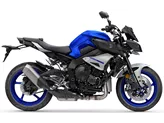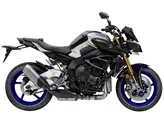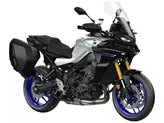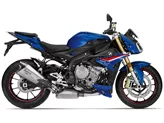Kawasaki Z 800 2013 vs. Yamaha MT-10 2016

Kawasaki Z 800 2013

Yamaha MT-10 2016
Přehled - Kawasaki Z 800 2013 vs Yamaha MT-10 2016
The Kawasaki Z 800 model year 2013 and the Yamaha MT-10 model year 2016 are both naked bikes with similar engine types, inline four-cylinder engines. However, there are several notable differences between the two motorcycles.
In terms of engine power, the Yamaha MT-10 takes the lead with 160 horsepower, compared to the Kawasaki Z 800's 113 horsepower. This significant difference in power output gives the Yamaha MT-10 an advantage in terms of acceleration and overall performance.
The torque figures also favor the Yamaha MT-10, with 111 Nm compared to the Kawasaki Z 800's 83 Nm. This higher torque allows the Yamaha MT-10 to deliver strong and responsive acceleration, making it a thrilling ride.
Both motorcycles feature liquid cooling systems, ensuring optimal engine performance and preventing overheating during long rides. Additionally, they both have four cylinders, providing smooth power delivery and a balanced ride.
In terms of suspension, both motorcycles feature upside-down telescopic forks at the front. This type of suspension provides better stability and control, especially during aggressive riding.

Kawasaki Z 800 2013
The chassis of the Kawasaki Z 800 is made of steel and has a double cradle design. On the other hand, the Yamaha MT-10 features an aluminum frame with a Deltabox design. The aluminum frame offers a lightweight and rigid structure, contributing to the Yamaha MT-10's agility and high-speed stability.
Both motorcycles have double disc brakes at the front, providing powerful and reliable stopping power. This is crucial for confident and safe riding, especially at high speeds.
In terms of tire dimensions, both motorcycles have a front tire width of 120 mm and a front tire diameter of 17 inches. However, the Yamaha MT-10 has a wider rear tire at 190 mm, compared to the Kawasaki Z 800's 180 mm. This wider rear tire contributes to the Yamaha MT-10's stability and grip during cornering.
The wheelbase of the Kawasaki Z 800 is slightly longer at 1445 mm, compared to the Yamaha MT-10's 1400 mm. This longer wheelbase provides a more relaxed and stable ride on the Kawasaki Z 800.
In terms of seat height, the Yamaha MT-10 has a slightly lower seat height at 825 mm, compared to the Kawasaki Z 800's 834 mm. This lower seat height on the Yamaha MT-10 may be more suitable for shorter riders or those who prefer a lower riding position.

Yamaha MT-10 2016
Both motorcycles have a fuel tank capacity of 17 liters, allowing for decent range and fewer fuel stops during long rides.
In terms of strengths, the Kawasaki Z 800 has an eye-catching, chunky look that appeals to riders who prefer a more aggressive and muscular design. It also offers confident acceleration and relaxed geometry, making it suitable for both city commuting and spirited riding. Additionally, the Kawasaki Z 800 has powerful brakes, providing excellent stopping power when needed.
On the other hand, the Yamaha MT-10 has a CP4 engine that delivers a strong character and exhilarating performance. It is extremely agile, allowing for quick and precise maneuvers in tight corners. The Yamaha MT-10 also offers high-speed stability, making it suitable for both urban and highway riding. Furthermore, it has strong brakes and an unmistakable sound, adding to the overall riding experience.
In terms of weaknesses, the Kawasaki Z 800 has limited freedom of movement for the legs, which may be uncomfortable for taller riders or those who prefer a more spacious riding position. On the other hand, the Yamaha MT-10 has poor comfort, limited wind protection, and a hard fit, which may not be ideal for long rides or riders who prioritize comfort.
In conclusion, while both the Kawasaki Z 800 2013 and the Yamaha MT-10 2016 are powerful naked bikes with similar engine types, the Yamaha MT-10 offers higher performance, agility, and stability. However, the Kawasaki Z 800 has its own strengths in terms of its eye-catching design, confident acceleration, and powerful brakes. Ultimately, the choice between the two motorcycles will depend on the rider's preferences and priorities.
Technické údaje Kawasaki Z 800 2013 ve srovnání s Yamaha MT-10 2016
Výhody a nevýhody ve srovnání
Výhody a nevýhody ve srovnání
Kawasaki Z 800 2013

Celkově podává Z800 senzační výkon. Vzhledem k tomu, že na vozidle nebylo kromě zadního tlumiče Remus nic měněno ani optimalizováno, je konečný výsledek super.
Yamaha MT-10 2016

Krátký a zavalitý MT-10 je z proslulých výkonných naháčů vzhledově i podvozkově nejvzdálenější superbiku R1, ale srdce MT-10 přímo vychází ze závodní zbraně a fascinuje jedinečným syrovým zvukem a výkonem odspodu díky typickému posunu klikového čepu, který s upraveným pořadím střelby zajišťuje tento jedinečný charakter. Výsledných 160 koní se proto jen na papíře jeví ve srovnání s více než 200 koňmi modelu R1 jako poněkud slabých, ve skutečnosti však i MT-10 rozpoutá neuvěřitelný ohňostroj. Odpružení by bylo pro závodní okruh asi příliš měkké, ale pro souboj na venkovské silnici je tak akorát, a stejně tak brzdy - pro okruh asi jen přijatelné, ale na venkovskou silnici ideální.
Srovnání cen průměrná tržní cena Kawasaki Z 800 vs Yamaha MT-10
There are a few key differences between a Kawasaki Z 800 2013 and a Yamaha MT-10 2016. In terms of price, the actual average price of a Yamaha MT-10 2016 is about 54% higher. There are the same number of bikes of both models available on the 1000PS.de marketplace, specifically 7. It takes less time to sell a Kawasaki Z 800 with 56 days compared to 97 days for a Yamaha MT-10. Since model year 2013 1000PS.de editors have written 11 reviews for the Kawasaki Z 800 and 32 reviews for the Yamaha MT-10 since model year 2016. The first review for the Kawasaki Z 800 was published on 9/6/2012 and now has more than 8,100 views. This compares to more than 20,700 views for the first review on Yamaha MT-10 published on 11/17/2015.





















